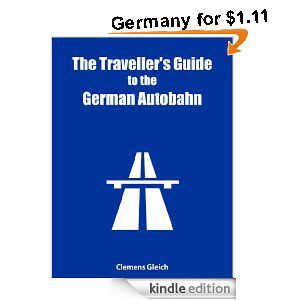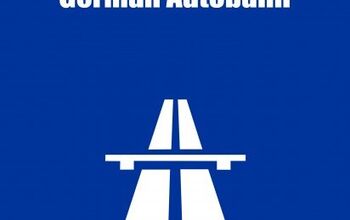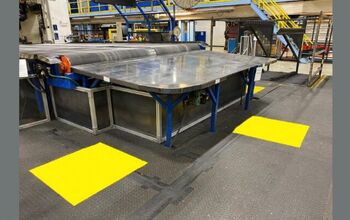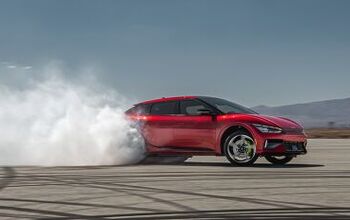Clemens Gleich's Traveller Guide to the German Autobahn, Part 2
Buy me now. Only $ 1.11
Many foreigners think that every Autobahn is basically the same, which can lead to a very unsatisfactory motor vacation, because it is easily possible to spend the whole length of it in absurdly limited sections and road works which means you might as well have stayed at home. There are some passages that not only are unlimited, but also have curvature radii that feel like a straight at 70 mph but tear your face off your skull (or your tires off the asphalt) at 170 mph. The A95 from Munich to Garmisch is a nice example (don’t go there on the weekends, when everybody and their mother will).
You could race down BMWs very own prototype test track: Enter the A92 leaving Munich, turn on the A3 towards Regensburg, at Regensburg go down the A93 towards Ingolstadt and Munich (A9). Rinse, repeat. You will see all those disguised next-gen BMWs and perhaps a few such Audis, too.
If you are looking for competition, visit the Kassel Mountains on the A7 (“Kasseler Berge” will give you Youtube-Clips galore, complete with infos on speed cameras on the limited bits). The Bahn through these hills is so steep that caravanists go a long way to avoid it for fear their underpowered bathrooms will be reduced to 20 mph or to going backwards very fast, disintegrating. This fact alone should tell you everything: few caravans, much competition, good road. To race the Kasseler Berge, follow the A7 from Bad Brückenau towards Kassel until you come to the Autobahndreieck Drammetal (A7 and A38 meet here). Yes, Google Maps is right: There are many miles in that bit.
Bring an amount of horsepower you would consider “too much” at home, otherwise you might leave the A7 a very frustrated man.
For pure, undiluted straight line speed visit the north of Germany where the landscape slowly peters out into the North Sea. A famous example of this experience of American motoring in fast forward is the A27 from Bremen to Bremerhaven: Going straight towards the horizon, towards the sea. Another good stretch are the 50 open km on the A7 from Rendsburg to Flensburg, Germany’s northernmost city, (in)famous for being the home of the points-on-your-licence database. If you don’t manage to max your car on these northern Autobahns, you need a slower one. Or bigger balls.
My personal favorite are the Autobahns of Eastern Germany. The East is a dark forested no man’s land that hasn’t changed since the Dark Ages, which is why it is also known as “Dunkeldeutschland” (“Dark Germany”). During the socialist occupation after the war, people were forced to live there at gunpoint, but when the wall came down, of course everybody with half an ounce of sense and two working legs left. Now, only ancient pensioners still haunt the ghost towns there, the rest has fled to Berlin or to civilized Germany (which funds the whole Berlin island setup).
As is customary, the government didn’t notice this and built infrastructure fit for two Irelands into the empty woods, financed by a special new extra tax cynically called “Solidaritätszuschlag” (solidarity surcharge). The Autobahns they built are gorgeous, empty and give me a feeling of my money well spent. The A2 from Magdeburg to Berlin is especially popular with tourists, because at the end of it, you are somewhere (Berlin) instead of nowhere (the rest of the East).
But my secret tip for you would be the A71 connecting Schweinfurt with Erfurt. It is still quite new, so it hasn’t made its way into the travel guides yet. You can go the whole length of it, the only limits being in the tunnelly bit. The tunnel stretches are a good place for a spot of R&R (relax and refuel), because there are nearly no service stations directly on the A71. Get off at Oberhof, race up an awesome hill course, pit stop, race down the awesome hill course, continue racing the A71. You can hold the pedal to the metal until it rusts into position – if you are brave or underpowered enough to leave it there in the many turns.
Another way of finding a good piece of Autobahn is asking a German who likes driving (i. e. any German) about his favorite segment. These favorites are everywhere, so one will always be near your lodgings.
3. The RulesIn Germany, we love rules. The only thing we love more than making The Rules is explaining The Rules to the ignorant, which I shall do now. Fear not, I will constrain myself to the rules concerning a happy holiday. As always, the rules are split into the official rules of the written law and the unofficial rules “you just know”. As the French expect visitors to know their history and culture and speak their language, the Germans expect you to know the unofficial rules without being told. You just know. Which is why I won’t tell you either.
But I’ll do something better, I’ll explain official rules only you will know, starting with the mysteries of the Kraftfahrstraße: The sign for an Autobahn is a white road on blue ground stretching into the distance, being crossed by a bridge (mnemonics: a big letter “A”). So when you see this but no limit signs, you are allowed to go as fast as you can afford. BUT (and not even many Germans know this) the Autobahn is not the only place in Germany where you can legally do that. Look for a blue sign with a white car front on it, it marks a “Kraftfahrstraße” (mnemonics: translate it literally into “poweerrr drive road”). If it has two lanes per direction OR a bit in the middle (bushes, concrete, doesn’t matter) and there are no limiting signs, you can go as fast as you want here as well.
These open roads residing between a Motorway and an A-Road are unofficially called Yellow Autobahns (“Gelbe Autobahnen”) because of the yellow instead of blue road signs, and you should cherish this information, because you can use it to shut up a German going on about The Rules in the pub at night. You can finish him off by adding that there is a Kraftfahrstraße sign at the entrance of the Nürburgring Nordschleife.
A rule I don’t have to remind the visiting speed tourist of is nonetheless interesting, even heart-warming: In Germany, it is forbidden by law to go so slow that traffic is hampered without a good reason (see §3 Abs. 3 Nr. 3 in our holy traffic bible StVO). Traffic will immediately be hampered the nanosecond you fall below the current speed limit. The law is not often enforced, but when it is, we celebrate like Americans when they have found another terrorist. Pray that the offender doesn’t pay his fine, as this will provide you with the rare opportunity to attend a (public) trial of a Peugeot driver where he will be condemned for his sins of slowness. The memory will last you a lifetime.
On a more serious note, I have encountered tourists having a debate about their alleged whiplash on the leftmost Autobahn lane, our overtaking lane. I’m afraid this is not tolerable behavior in Germany. In fact, it is a criminal offence over here (dangerous intervention into traffic). If you get screamed at by a policeman who kicks you so hard his jackboot will stay stuck between your buttocks and then writes fines full of numbers you didn’t know existed, you will have been very lucky.
If somebody gets seriously hurt because of such stupidity, you will go to prison for “not under one year” and still be a bit lucky because you didn’t get killed by one of the many 2-tonne projectiles you were standing in the way of. You’ll see the wisdom of our legislation as soon as you come across a standing (stupid) obstacle on the overtaking lane while doing 190 mph in your 911 rental. Okay, it might be your last thought, but there are worse last thoughts.
To discuss your fender bender or the finer points of whiplash, you’ll have to leave the Autobahn, as it is completely verboten to stop anywhere on it, including the hard shoulder. The hard shoulder is for real breakdowns and emergencies, of which a spirited whiplash discussion is neither.
To cheer you up again, let me tell you another officially legal and accepted use of the hard shoulder: acceleration. If your vehicle is too feeble to get up to motorway speeds on the acceleration lane, you are not only allowed, but expected to continue your acceleration on the hard shoulder until there is an acceptable velocity to enter the Autobahn like a Gentleman (i.e. fast). But try real acceleration before you resort to this, which rally legend Walter Röhrl describes thusly: “Acceleration happens when the tears of a deeply moved heart roll along horizontally towards the ears.”
4. The TimeThe best time to visit our Autobahnen is in the summer, because we’ll all be gone on holiday then. Typically, a German gets 30 days of vacation a year and receives extra payment for this very vacation, so that he may leave his country for a while. It is much easier to love Germany from afar.
You can find tables on the Internet detailing the school holidays of all the German federal states you want to visit for an inkling of the remaining Autobahn traffic you can expect. Warning: At the beginning or the end of these school holidays you can forget to go anywhere fast on the respective Autobahn that provides the fastest way to the German federal state of Mallorca.
There are also many speed limits that are only effective by day. You could for example go from Stuttgart to Munich in well under an hour at night … or so I have heard. And of course you will have the motorway network to yourself during all major football matches with Germany in them.
Concerning the future of our motorways: You might have heard the German Green Party’s efforts to establish a general speed limit on the Autobahns. I can assure all you tourists this is something to yawn on and then forget. These efforts exist since before the Green Party existed. They have never gone anywhere. Green means GO!!!!!
You see, in general, Germans don’t care much about freedom. They will happily trade freedom for more order every time. But the Autobahn is the one exception. The freedom to drive as fast as we want is the only one we are prepared to fight for. To the German, speeding is like owning guns to the American. A general speed limit seems un-German to us, has a socialist stench, maybe even something French about it.
So I’m delighted to say that the unlimited speed of our Autobahns will be there for you as long as we German Autobahn Raser (a majority group) can still hold a weapon to defend your motoring holiday. Don’t worry about the cost: The German government collects nearly a Euro per liter as tax from your petrol bill and as I have said before: You will need A LOT of fuel.
Yours sincerely,
The German Ministry of High Speed Transport Propaganda
ACHTUNG: As our Canadian overlords have put us on a financial starvation diet, which forces me to rent-out my wife into yellow slavery, while Derek takes a night job at Chippendales Toronto, I am unable to pay the Minister of High Speed Transport Propaganda a reasonable, or even an unreasonable amount. Therefore, we did cut a deal: You click here.
If you do as told (and there is no other vay in Germany), then Clemens might come back. If not, I’ll come after YOU. Bertel
More by Clemens Gleich
Latest Car Reviews
Read moreLatest Product Reviews
Read moreRecent Comments
- Bd2 Eh, the Dollar has held up well against most other currencies and the IRA is actually investing in critical industries, unlike the $6 Trillion in pandemic relief/stimulus which was just a cash giveaway (also rife with fraud).What Matt doesn't mention is that the price of fuel (particularly diesel) is higher relative to the price of oil due to US oil producers exporting records amount of oil and refiners exporting records amount of fuel. US refiners switched more and more production to diesel fuel, which lowers the supply of gas here (inflating prices). But shouldn't that mean low prices for diesel?Nope, as refiners are just exporting the diesel overseas, including to Mexico.
- Jor65756038 As owner of an Opel Ampera/Chevrolet Volt and a 1979 Chevy Malibu, I will certainly not buy trash like the Bolt or any SUV or crossover. If GM doesn´t offer a sedan, then I will buy german, sweedish, italian, asian, Tesla or whoever offers me a sedan. Not everybody like SUV´s or crossovers or is willing to buy one no matter what.
- Bd2 While Hyundai has enough models that offer a hybrid variant, problem has been inadequate supply, so this should help address that.In particular, US production of PHEVs will make them eligible for the tax credit.
- Zipper69 "At least Lincoln finally learned to do a better job of not appearing to have raided the Ford parts bin"But they differentiate by being bland and unadventurous and lacking a clear brand image.
- Zipper69 "The worry is that vehicles could collect and share Americans' data with the Chinese government"Presumably, via your cellphone connection? Does the average Joe in the gig economy really have "data" that will change the balance of power?








































Comments
Join the conversation
If you have spent the evening in the company of fine friends celebrating the summer solstice in the hills and thus find yourself unable to navigate on foot because somehow conditions in the Fränkische Schweiz have become too windy, simply turn over the keys to your sober significant other and advise to stay in the right lane and do the posted speed limit or 100, whichever is greatest. If your significant other is tachophobic, do not be surprised when a Renault Kangoo passes at what appears to be hypersonic speed on the short unlimited stretch between Forchheim and Erlangen as 100 KM/h is really quite slow, and being startled in such a delicate state (see windy, above) may cause you to break out in laughter. This laughter may cause your significant other to become offended and cause them to lose all sense of sympathy when you are moving slowly the following day. And remember - never drive when it's too windy to walk or bicycle, no matter the country.
the body damage you describe on cars parked in Paris streets, is not necessarily due to being hit by another vehicle, the French have a nasty habit of "christening" your new vehicle with gratuitous dents and scratches. Also, while the German Polizei may have occasional evening road checks for inebriated drivers, the Polizei also knows the sober driver rule, so more often than not, the Polizei performs such checks in the morning, when the last night drunkards still have over the limit alcohol in their bloodstream and are driving to work, happy as a clam.